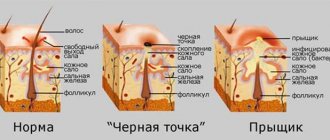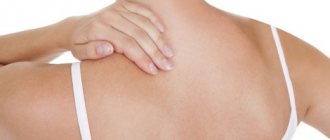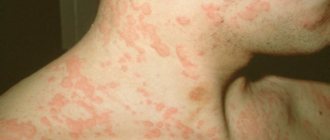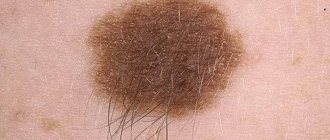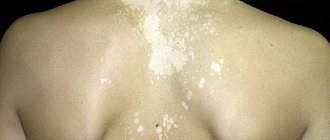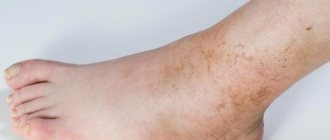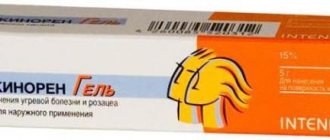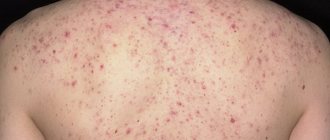Spots on the back can appear at any age and for a variety of reasons. Moles and freckles are nothing to worry about, but there are other types of rashes that look disgusting or disguise themselves as harmless pigmentation.
Unusual spots may be the result of hormonal imbalances, which disrupt the production of melanin pigment. Therefore, pregnant women or women during menopause notice brownish rashes on their bodies. In older people, they appear due to aging skin. Also one of the reasons is a lack of vitamins. Genetic predisposition and individual skin characteristics play an important role.
If the rashes are only a cosmetic defect, you can get rid of them with the help of cosmetics or home remedies, or salon procedures. But if the defect is based on a disease, you first need to deal with the root cause, otherwise eliminating pigmentation will not be effective.
Diseases that cause spots on the back
Typically, rashes on the torso are a symptom of skin diseases. But pigmentation on the back is not always a sign of dermatitis. Here are the main diseases associated with the appearance of spots on the back.
- Vitiligo. White spots on the back and other parts of the body due to the destruction of melanin. This happens under the influence of heredity, decreased immunity, and impaired skin trophism. Other causes include hormonal disorders, gastrointestinal diseases, and chemical burns. In this case, the lightened areas can be flat or raised. Some have a bluish tint. The disease itself is not dangerous, but it is often accompanied by disturbances in the digestive system, various dermatitis, and eye inflammation. Different forms of the disease require special treatment. It would be good if we could find a connection between vitiligo and another pathology. Otherwise, therapy will be aimed at restoring melanin production and eliminating cosmetic defects, which is not always effective.
- Angioma of the spinal cord. Pathological growth of the vascular wall into a benign tumor. It threatens the destruction of nerve endings responsible for movement and internal bleeding. A brown spot appears along the spine, which increases in size over time. The skin becomes numb and tingling is felt. Pain occurs, radiating to different parts of the body. A small tumor requires conservative treatment and medical supervision. A rapidly growing tumor is removed surgically.
- Syphilis. An infectious disease, most often sexually transmitted. The causative agent is Treponema pallidum. If left untreated, after the incubation period is completed, the disease progresses to the next stage. Secondary syphilis is characterized by light rashes over the collarbones and shoulder blades, vascular pink and red spots on the back and limbs, and hair loss. Lymph nodes are enlarged but painless. Body temperature rises, cough, runny nose and conjunctivitis appear. Such symptoms last for 1-2 weeks, then disappear. The disease enters a chronic stage with damage to internal organs. Penicillin antibiotics are used for treatment.
- Infectious diseases. Diseases such as rubella, scarlet fever, measles, chickenpox are characterized by a strong increase in temperature and profuse rashes in the form of red spots, blisters with liquid, pimples, itchy blisters. Patients are prescribed local treatment, taking antibacterial drugs and vitamins, as well as complete rest during the recovery period.
- Eczema. Non-contagious inflammatory skin disease. It is a consequence of allergies, hormonal and nervous disorders, and metabolic failure. It can also be caused by microbes and fungi. There are several types of the disease, but they have common features. The affected area turns red and becomes covered with ulcers and blisters with purulent or serous contents. After they heal, plaques covered with scales remain on the skin. At the same time, itching and burning are felt. Patients are prescribed antihistamines, drugs for skin healing and regeneration, and diuretics to speed up blood filtration.
- Pityriasis versicolor. Fungal disease of the stratum corneum of the epidermis. Characterized by the appearance of yellow, pink and brown spots on the back and chest. The rash gradually merges with each other, forming extensive foci. Their shade is constantly changing. Therefore, the second name of the disease is lichen versicolor. To eliminate the pathology, antifungal drugs are prescribed for external and internal use. Exposure to ultraviolet light helps to overcome the pathogen, so sunbathing is beneficial. Other types of lichen (squamosus and rosea) also cause rashes on the back.
Of all the above, only tinea versicolor does not pose any threat to health even in the absence of treatment. The only discomfort is the appearance of many brown spots on the skin.
Benign tumors
Benign tumors are tumors whose cells have a number of properties that are not inherent in normal cells of the body: the ability to divide and grow uncontrolled. The presence of benign tumors indicates a number of disorders in the body.
Halonevus
Pigmentation with a light rim around it may represent a halonevus, that is, a benign neoplasm that appears as a red spot on the back, which, as a rule, does not itch or hurt and which in itself is not dangerous. To exclude the appearance of malignant tumors, an examination by an oncologist is necessary.
Melasma
Melasma is characterized by red patches on the back and abdomen. It is benign and occurs as a result of:
- strong exposure to ultraviolet radiation;
- taking hormonal medications and contraceptives;
- pregnancy and lactation;
- genetic predisposition.
All benign skin growths should be examined immediately, as they can develop into malignant ones over time.
Spots on the back photo
How to get rid of it?
If such a defect appears, you should consult a dermatologist. He will conduct the necessary research, prescribe treatment or select a safe way to eliminate unwanted pigmentation.
Products based on salicylic alcohol, citric acid, and hydrogen peroxide have a good whitening effect. You can buy them at the pharmacy or prepare them yourself. It is important to strictly follow the dosage to avoid burns. Beauty salons offer procedures to get rid of stains:
- cryotherapy (exposure to liquid nitrogen);
- laser removal (removal of the top layer of skin with a light beam);
- mesotherapy (administration of drugs with a whitening effect);
- peeling (partial removal of the epidermis with chemicals).
Prevention of such rashes is proper nutrition, strengthening the immune system and dosed exposure to the sun. You should take a responsible approach to the choice of detergents and cosmetics. Hormonal medications can only be taken as prescribed by a doctor.
Not all spots on the back are harmless. Sometimes unusual pigmentation is one of the symptoms of a dangerous disease. You should not try to deal with it on your own; if it appears, you should consult a dermatologist.
Only a doctor should identify the causes and treat red spots on the back of a man or woman. The symptom can be caused by various dangerous diseases, which, in the absence of appropriate help, lead to negative consequences.
Appearance of skin pigmentation
Pigmentation in the form of dark spots on the back can be caused by a number of pathological and completely harmless reasons.
Freckles
A dark spot on the back can result from the spring appearance of freckles, which affects fair-skinned people with red or blond hair. Medically, these rashes are not dangerous, and procedures from a dermatologist or cosmetologist will help to cope with them.
Chloasma
Brown spots on the back may be a manifestation of chloasma. Chloasma is caused by the following reasons:
- liver diseases (hepatitis, cirrhosis);
- inflammation in the female sphere (adnexitis, endometritis, salpingitis);
- use of incorrectly selected contraceptives;
- too intense artificial or natural tan.
Chloasma is a direct reason to consult a doctor and conduct a thorough examination.
Types, symptoms, diagnosis
Red spots on the back can appear at any age. They are divided into several types, which differ in shape, size, shade, depending on the causative factor.
Spots on the back area can be:
- rising above the level of the skin or flat;
- with a dry or wet surface, smooth or rough;
- swollen and inflamed;
- with clear or vague boundaries;
- with or without itching.
The color can vary from pinkish to distinct red and purple.
If a red spot appears on your back, like a burn, which is not prone to spreading, you should not worry. It is enough to observe him for 2-3 days. If other symptoms occur, such as itching or flaking, you should visit a doctor.
Warning symptoms, the presence of which should undergo a comprehensive diagnosis:
- severe itching syndrome, which brings significant discomfort;
- the appearance of a flaky surface on acne;
- burning, redness, increased local temperature;
- transition of dry pimples into weeping pimples;
- an increase in the size of the spots, the appearance of pain, which intensifies if you press on them.
A dermatologist diagnoses and treats red spots on the back that itch and flake. First of all, an external examination of the affected area is carried out, information is obtained regarding the accompanying symptoms that complement the skin rash.
To confirm the diagnosis, laboratory tests are prescribed: examination of scrapings from the surface of the spot, skin tests to identify the allergen. If a disease of an internal organ is suspected, instrumental diagnostics (ultrasound, CT or MRI, x-ray) are performed.
Allergic manifestations
Allergic skin rashes can appear in the form of red itchy spots, localized not only on the back, but also on the shoulders and arms. Red spots may have white bumps.
Skin rashes appear due to photodermatitis, that is, an allergic reaction to direct sunlight.
Eczema
If red spots with pimples appear on the body and itch, it may be eczema. Red spots tend to be localized on the shoulders, chest and back, arms and even the face. Eczema is allergic in nature and develops against the background of:
- endocrine disorders;
- nervous system disorders;
- chronic infections;
- digestive disorders;
- metabolic disorders.
With such manifestations, a person needs complex therapy.
Possible provocateurs
Red spots on the lower back in an adult occur due to the following factors:
- allergic reaction;
- a bite of an insect;
- stress and disturbance of psycho-emotional background;
- infectious skin disease;
- parasitic influence;
- dysfunction of the cardiovascular system.
The most harmless reason for the appearance of large round spots or small dots on the back is an allergic reaction. The rash itches but does not peel off. Provocateurs are food products, especially citrus fruits, laundry detergent, shower products, clothing material, etc.
One form of an allergic reaction is photodermatitis, the symptoms of which arise against the background of increased sensitivity of the skin to ultraviolet radiation. You may notice the appearance of persistent redness, spots of different sizes, itching, burning, and blisters similar to a burn. In some cases, photodermatitis occurs due to systemic lupus erythematosus.
Erythema is redness on the skin that is caused by dilation of capillaries and increased blood flow. This occurs against the background of emotional stress or physical overload, after cosmetic procedures, massage. Blood flow is also activated after being in the bathhouse. Large spots appear that disappear on their own without requiring specific therapy.
With rubella measles, the body is covered with a small red rash, which is more localized on the skin of the back, thighs, buttocks, neck and face. On the second day, the spots gradually begin to disappear.
Reddish small dots occur with the development of scarlet fever. The neoplasms are only a few millimeters in size. Preceding symptoms are: sore throat, heaviness in the groin and lower abdomen. Along the circumference of the plaques, the skin becomes slightly swollen and inflamed.
With chicken pox, pimples appear all over the body. The disease has an infectious etiology and is contagious to others. At the initial stage, small itchy spots appear in one area of the body, quickly spreading to healthy areas. Over time, they turn into watery blisters and dry out, forming crusts.
Another contagious disease is ringworm or microsporia. It is caused by specific fungi of the genus Microsporum. Round plaques appear on the body, with a lighter area in the center. The limbs and head are most susceptible to symptoms.
During periods of maximum weakening of the body's protective function, the herpes virus is activated, which causes Zhiber's pityriasis rosea. A bright red spot with a diameter of 3-5 cm appears on the lower back or in other parts of the spine and the entire torso. During the first 7 days, secondary formations of a smaller size appear near the primary plaque.
Ringworm or eczema is characterized by the appearance of a rash that has a light red tint. Itching occurs. Over time, pimples transform into watery cavities, which, after opening, leave pinpoint erosions and flaky crusts.
Psoriasis is characterized by autoimmune origin. Light red spots appear on the body, which have a smooth surface. After 2-3 days, the rash becomes flaky with silvery-white scales and merges to form large plaques.
It is not uncommon to have a parasitic infection of the body. During their life, pests emit harmful substances to which the body reacts with symptoms from the skin. At the initial stage, small pimples appear, which itch and eventually turn into ulcers.
Autoimmune disorders
Autoimmune diseases develop as a result of the pathological production of autoimmune antibodies or the proliferation of autoaggressive clones of killer cells against healthy, normal tissues of the body. The described dermatological symptoms may indicate autoimmune diseases.
Psoriasis
With psoriasis, red spots with white bumps and flaking scales appear on the body. Red spots on the back are usually itchy. They are localized on the elbows, lower back, between the shoulder blades, and on the head. This disease is autoimmune in nature and indicates serious disturbances in the functioning of the immune system. Psoriasis is not contagious and is not dangerous for the patient’s loved ones, however, this disease is a reason to go to the hospital.
lupus erythematosus
Lupus rarely appears as patches on the back. Red spots appear on the arms, stomach, face. With this disorder, not only the skin is affected, but also blood vessels, joints, and many organs.
Dark and red spots on the body can be due to various reasons, representing a certain degree of danger to the body. In any case, the final diagnosis and adequate treatment, if necessary, can be prescribed exclusively by a qualified specialist.
Spots on the back indicate the presence of a disease or a malfunction of the endocrine system.
Even a seemingly harmless mole can develop into skin cancer, so you should not downplay the significance of any formation on the body.
It is important to know how dangerous such stains are and whether they are simply an aesthetic defect.
Treatment and prevention
For allergic etiology of skin rash, you need to take antiallergic drugs in the form of tablets. Antihistamine ointments are applied locally to eliminate itching and hyperemia.
If eczema or dermatitis develops, the use of ointments and creams from the group of antifungal, antibacterial, and hormonal is prescribed. If there is excessive weeping of the rash, it is recommended to apply lotions.
For infectious etiologies of skin rashes, antibacterial agents are used in local and oral form. To relieve itching syndrome, you can treat the affected areas with infusions and decoctions based on medicinal herbs.
Skin symptoms caused by a violation of the psycho-emotional state are treated with sedatives and drugs aimed at strengthening the central nervous system. You can take an infusion of valerian, which is sold in finished form at the pharmacy.
To increase the body's defenses, vitamin complexes are prescribed, which contain ascorbic acid, potassium, magnesium, phosphorus and other useful substances.
The basis for the prevention of dermatological diseases of fungal and bacterial etiology is hygiene. If you carry out water procedures daily, most pathogenic microorganisms leave the skin, and excess dirt, dust, secretions of the sebaceous and sweat glands, which provoke the development of inflammatory reactions, are also removed.
When taking a bath, it is recommended to add sea salt, infusions and decoctions based on medicinal herbs, bran, linden blossom, chamomile flowers, previously placed in a gauze bag, into the water.
You need to eat a balanced diet. Some foods play a direct role in maintaining skin health. First of all, these are fatty fish, seaweed, green leafy vegetables, nuts, fruits and vegetables, and dairy products.
Skin symptoms vary in people with coronavirus. Some indicate a milder course of COVID-19, while others serve as a marker for a severe variant of the disease. Knowledge of skin manifestations of COVID-19 will help to diagnose the infection earlier and correctly assess the risks of each patient.
Folk remedies
A few useful tools:
- For 200 g of pork fat, juice of one large lemon and 2 tbsp. l. honey. Helps with moles and infections. Not for children under 10 years of age, during and after cancer, dry skin, skin ulcers. Store the mixture in a cool place. Before applying, keep a little of the mixture at room temperature.
- 2 tbsp. l. finely grated horseradish and 4 tablespoons of honey mix thoroughly. Let sit for 48 hours. Add 8 tbsp. l. goat fat. Mix thoroughly. Let stand for 6 hours. The method of application and storage are the same as in the previous mixture.
- For 0.5 liters of yogurt 2 tbsp. l. soda 4 tbsp. l. coarsely grated horseradish. Let stand for 48 hours in a cool place. Apply a thin layer or blot with a cotton swab.
- For 200 ml of milk 1 tsp. daisies. Boil in a water bath for 15 minutes. Cool. Express 100 ml. If you add 0.5 tsp of goat fat and butter to the previous composition, it is good for removing diaper rash in babies. After 15 minutes, rinse with warm boiled water.
- Water for babies should be boiled and settled; After that it boils again, drains 1/2, cools, and washes out the diaper rash. The upper third of the decoctions is taken for washing.
- For 1 liter of boiling water, 1 tsp. celandine, nettle, chamomile, plantain, 200 ml of aloe juice. Use if there are inflammatory seals in the soft tissues. If you add 0.5 liters of grated garlic to the composition, the composition removes fungal stains. If you add 0.5 liters of honey to the initial composition, you can use a compress for hopelessly ill babies with staphylococci. If you remove celandine from the composition, the product helps with intestinal infections.
Before and after applying any products that have a drying effect, it is important to wipe the skin with decoctions that have a softening, disinfecting effect. After applying the composition and rinsing it off, it is advisable to apply a baby moisturizer or baby cream to the skin.
If there are spots on your back that peel, itch, and even when there is no itching, it is important to consult a doctor, at least a therapist. Skin is often an indicator of internal health, so it needs to be given attention.
| Psoriasis | A chronic autoimmune disease that occurs with alternating periods of remission and exacerbation. It is characterized by the appearance of psoriasis itchy plaques on different parts of the body, including the back. They have a textured structure, are dry to the touch and covered with a white coating. At the initial stage, it almost always appears as a small red spot the size of a coin. | |
| Scabies | The disease is caused by scabies mites and is characterized by the appearance of an itchy rash on the skin with visible passages of the parasite. Exacerbation occurs at night. May appear as many small red dots throughout the body. | |
| Neurodermatitis | The disease is chronic and develops under the influence of the following factors:
| |
| Seborrhea | There can be 3 types: dry, oily and mixed. | |
| Skin infections | Folliculitis and impetigo cause pimples that become inflamed and produce pus. Itching on the back in one place may be due to the appearance of new growths. | |
| Fungal infections | Lesions on the back can be caused by lichen ruber, which occurs when there is sensitivity to pathogens on the skin. | |
| Endocrine diseases | In diabetes mellitus, the back itches in the area of the shoulder blades due to the sedimentation of crystalline sugar in small vessels, while kidney function is disrupted and toxins accumulate in the body. The dermis becomes dry and thin. It can be very itchy. | |
| Pathologies of the liver and gallbladder | The occurrence of itching due to intoxication of the body and the effect of bile acids on the nerve fibers of the skin. | |
| Iron-deficiency anemia | Itching appears with hemoblastosis (blood cancer) in the first stages of the disease. | |
| Mental disorders | Itching is divided into: | |
| Pinched nerves of the spine | Itching occurs as a result of compression of the nerves of the spinal column by deformed intervertebral discs. | |
| A bite of an insect | ||
| Poor hygiene | ||
| Sunburn | ||
| Senile itch | Occurs in people over 60 (mostly men) due to:
| |
| Dry skin | ||
| Increased sweating | ||
| Lymphogranulomatosis | Inflammation of the lymph nodes is often accompanied by skin itching and burning. | |
| Excessive amount of water procedures | ||
| Taking drugs of a narcotic nature | ||
| Pregnancy, menopause, menstrual irregularities | ||
| Breast cancer (prostate in men) | The same place on the back itches due to the formation of toxic products, as a result of necrosis of pathogenic cells and their vital activity. | |
| Cerebrovascular accident | ||
What we know about skin symptoms of coronavirus
There is no definitive summary data on the dermatological manifestations of COVID-19 from around the world, but there is information from China, Spain, England and the USA. In these countries, studies were conducted at national medical centers where patients with coronavirus were treated; in total, doctors described more than 350 cases of COVID-19 with skin symptoms.
Early studies from central China suggested that skin conditions were rare in COVID-19 patients. Among the first 1,099 people infected in Wuhan, only two patients experienced skin symptoms (0.2%).
Skin lesions were first noticed in patients in intensive care units, which is not surprising: they receive more attention from doctors.
Now there is a special online registry on the dermatology of the new coronavirus, where all countries can share recorded cases of skin manifestations of COVID-19. Its main goal is to quickly and efficiently collect medical information that will help in treating the disease.
Let's go to the doctor
If spots appear on the shoulders and back in children under 12 years of age, you should immediately consult a doctor. Self-inappropriate treatment of urticaria and other problems leads to kidney dysfunction, skin cancer, and significant compaction in the tissues.
Folk remedies can dry out the skin: stretch marks, wrinkles, deformation of the walls of blood vessels, blood clots.
After examination, the doctor will prescribe suitable treatment depending on the cause. For example, he will tell you what it is and how to treat it.
It is important for adults to consult a doctor in all cases of foreign pigmentation.
Stains pose a serious danger if:
- reddish formations are round, oval;
- the size of the formation is more than 5 mm in diameter;
- the temperature rises sharply to 38 and above;
- redness rises above the surface of the skin more than 2 mm.
It is better to contact a dermatologist, regardless of the appearance and color of the formation. He will give directions for tests and other diagnostic methods.
How to distinguish different types of rashes
In order to move on to the clinical forms of skin manifestations of coronavirus, you must first understand the dermatological terminology. The rashes differ from each other, but each of them refers to a certain morphological element that we see on the skin.
Morphological elements characteristic of COVID-19 include:
- Spots or macules that appear only as a change in skin color. Red, purple and bright pink appear when a vessel is injured. Brown ones show local accumulations of melanin, for example, after long exposure to the sun without sunscreen.
- The spots on the body and face can resemble a small rash, form outlines in the form of stripes, bruises and bruises, or ecchymoses, in medical terms. The smallest spot, up to 15 mm, is called roseola, and larger than 20 mm is called erythema. Usually it is not even one element, but a merger of several.
- Papules are an element that rises above the skin level, the color of which can vary from normal to bright red.
- Blisters and vesicles are similar to papules, but they contain fluid inside. Larger rashes are called bullae and blisters.
- Blisters (urticaria) are rashes that are white, pale pink or even light red. The blisters rise above the skin and are often accompanied by itching. They can be small, 2-3 cm, or large, 10-15 cm. They are round, oval or irregular in shape, with lace edges.
Understanding the signs in a newborn
If a newborn has a red spot on his back or several such formations, this may indicate diaper rash. Urea and lack of oxygen cause thinning of the skin. Afterwards, inflammation affects soft tissues and blood vessels. Ulcers form at the site of diaper rash.
A single formation without burning is a sign of chafing. Unpleasant sensations appear on the second day after manifestation. If it swells, the temperature rises to 38 - infection. If pulsation is noticeable on or near the spot, soft tissues are affected: accumulation of helminth larvae, allergy to soap due to improper rinsing.
If there is severe pain, the child turns blue when crying - cancer. The red spot turns blue - a stroke or increased blood pressure.
Formations, red without rims, localization expanding - food allergy. May be accompanied by diarrhea or constipation, fever. In the baby, the muscles on the red spots are deformed, boils, nausea, vomiting, diarrhea are formed - streptococci, staphylococci.
Frequent skin manifestations of COVID-19
The most common skin manifestation of the new coronavirus is erythematous-edematous lesions. These are spots of different diameters and various shades of red. They do not itch, but the affected skin feels warm or even hot to the touch.
Skin manifestations are not random: many of them are characteristic of a certain age group of patients or the severity of the disease.
Severe COVID-19
Acro-ischemia affects the fingertips, balls of the feet, or the skin of the heel area. Severe COVID-19 can lead to hypercoagulability—excessive thickening of the blood. It passes through blood vessels with difficulty, especially small ones - capillaries and venules, which leads to their damage, stagnation of blood and the formation of blood clots - thrombi.
The most severe and complex patients are those who, in addition to the tips of the phalanges, have a bluish coloration of the skin and mucous membranes (so-called cyanosis).
The most common rash seen in patients with the new coronavirus is maculopapular or maculopapular rash. It lasts about nine days from onset and primarily affects the thighs, forearms and shoulders.
Moderate severity of COVID-19
Researchers associate a rash resembling chickenpox with intermediate severity of the coronavirus. Most often, this symptom manifests itself in middle-aged patients.
As with chickenpox, the rash consists of small, identical blisters that cover the skin of the body. But true chickenpox and similar viral exanthema appear only after contact with someone who is already infected with these infections.
In the case of COVID-19, this rash lasts about ten days and disappears along with other symptoms, and sometimes even before them.
Mild form of COVID-19
Rashes on the fingers and toes, similar to frostbite, may appear with mild cases of coronavirus in children or young people. The average age of patients with frostbite-type rashes is 14 years. Doctors found this manifestation in 25 patients in Spain and 11 children in northern Italy. They had neither typical coronavirus symptoms nor objective causes of frostbite, and the test result for COVID-19 was positive.
When a frostbite-type rash occurs, bright red spots with a pink-violet tint appear above the surface of the skin. The affected areas, as a rule, are located asymmetrically, and after recovery, the symptoms go away without any treatment, leaving no scars.
The rash with petechiae, small pinpoint hemorrhages, as with the purple rash, did not affect the skin of the palms and soles, and there was no manifestation on the oral mucosa. This symptom does not always indicate coronavirus; it can also be caused by other infectious diseases or a reaction to medications. Biochemical blood tests and virological studies will help distinguish them.
Of the 27 children with mild disease, two developed a targetoid (target or ring) lesion resembling erythema multiforme. In this case, the round spots have a red center with a vesicle, resembling a target. These rashes can be grouped together. This symptomatology is typical for herpes simplex, but none of the patients suffered from it.
In targetoid lesions, there are three color zones: a dark center with a blister or crust, a pale pink raised surface due to swelling around it, and a bright red outer ring. Targetoid lesions appear on any part of the body, including mucous membranes such as the lips.
Cutaneous manifestations have received increasing attention during the COVID-19 pandemic as they may be useful for early diagnosis, especially in children and the elderly.
If you notice a rash on yourself or your child, remember if you have been in contact with people with chickenpox or other infections with a characteristic rash. Could this be a manifestation of an allergy to food, cosmetics or cleaning products? If not, immediately contact a dermatologist who will accurately diagnose and prescribe treatment.
Changes on the body cannot always be noticed immediately unless they are accompanied by itching. Tangible discomfort forces a person to find out the reason why a red spot appears on the back and the area between the shoulder blades or ribs itches. But often areas of the skin become brown or lack pigmentation, and other symptoms are added over time. In a similar way, the body reacts to changes in the functioning of internal organs, neoplasms, irritation or other pathologies, so identifying provoking factors is important for timely treatment.
Spots along the vertebral region
Spots along the spine indicate the following problems:
- rheumatism;
- localization of salts;
- inflammation of the spinal cord;
- accumulation of helminth larvae;
- wearing hard or synthetic underwear;
- strong tan – the skin becomes thinner and degreased;
- excessive loads, due to which capillaries crack;
- allergies due to skin damage by external irritants;
- slight displacement of the vertebrae in combination with a cold in the back;
- excessive sweating due to pathological enlargement of pores in this area;
- unskilled massage: warming agents and sudden movements create stretch marks on the skin, hematomas, weakening of the walls of blood vessels, periodic hemorrhages;
- reactive inflammatory processes - juvenile arthritis, juvenile osteochondrosis, osteoporosis.
Dangerous accompanying symptoms
If red spots appear or a slight itching sensation, you should analyze your diet, the start of taking pills, and the circumstances that could lead to discomfort. Perhaps the reason was sweating, visiting the pool, beach, solarium, and the skin simply needs additional care or a change in cosmetics. But if a brown spot appears on the back and itches periodically between the shoulder blades, it is necessary to undergo an examination along the spine to exclude the appearance of a tumor or to begin treatment at an early stage.
Other accompanying symptoms should also alert you:
- severe peeling, cracking of the epidermis, ulcers;
- tubercles with serous fluid;
- severe itching, the intensity of which increases at night;
- temperature increase;
- occasional pain or tingling;
- swelling at the site of the spots;
- loss of skin pigment in certain areas.
Violation of the integrity of the skin due to scratching from itching, even if the initial cause of discomfort was not serious, carries a risk of infection.
Peeling and itching - everyone around is shouting about the problem
Sharp, sudden itching is an allergy to an external irritant. Color - light red with dark red splashes in the center. If the itching gradually intensifies, the formations are red or dark red - an internal allergen.
If there are flaky spots on your back, you need to carefully look at the whole body.
The spots on the skin are flaky and itchy in the photo:
Here are some more important reasons:
- Psoriasis at the initial stage appears as red areas with a hard formation in the center. The exception is the callosal form. With enough ultraviolet light, the skin exfoliates. At the remission stage, there are white areas with minor peeling.
- Mycosis . The formations are whitish with a yellowish or creamy tint, moderate itching with gradual exfoliation in the form of transparent flakes.
- Syphilis . Oval pink areas may indicate the first stage of syphilis. On the affected area, the skin is drier and tougher, with moderate itching.
- Vitamin deficiency - from white to light red. Exfoliation due to vitamin A deficiency.
- Ringworm : white to brown in color; the skin becomes rough 3-7 days after its color changes; itching is felt when immunity decreases; exfoliation 3-8 days after hardening of the affected area.
